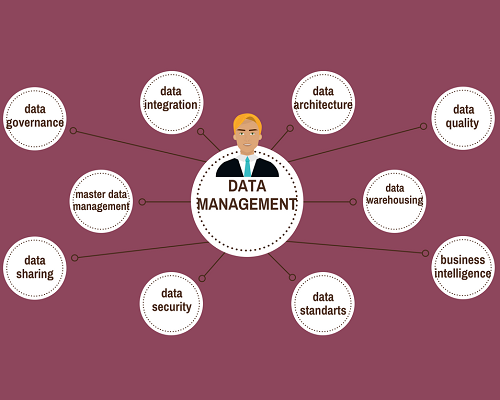Data plays a crucial role in determining how a business runs and how it makes decisions. However, there is a huge amount of data available over the internet in various forms that can be beneficial to businesses.
With the growing amount of data, businesses need to arrange it in such a way that it should be useful for them. Without proper management, data is just an unwanted piece of scrap. Companies need a strong strategy, good governance, and an effective data management model to use data effectively.
Today, in this article we will understand what data management is, its process, its importance, and much more.
Data Management Definition
Data management is a process of collecting, organizing, and handling data to improve the overall productivity, efficiency, and decision-making of a business. Today, data is crucial for businesses of all sizes and industries. To make the most of this data, companies need a strong strategy and a modern data management system. Effective data management supports various needs like running business processes, meeting regulations, providing accurate business analytics using AI, and driving digital transformation.
Data Management Process
The data management process involves several important tasks and procedures, let us understand the step-by-step process of data management with the help of the points written below:
- Collecting and Processing Data: This step is about gathering data from various sources, making sure it is in the right format, and checking it for accuracy.
- Integrating Different Types of Data: Data usually comes in many forms, like structured data which is organized in rows and columns, or unstructured data like emails or social media posts. This step involves combining all these different types of data into a common format, making it easier to use.
- Managing Data Quality: It is important that data should meet certain business standards. This step ensures that the data is accurate, consistent, and useful.
- Providing Collaboration and Access: This means making data easily accessible to the right people in the company. It also involves tools that allow team members to work together and use the data without needing expert help.
- Protecting and Securing Data: The company’s data needs to be protected from unauthorized access and breaches. This is the step that involves setting up measures to protect the data and ensure privacy.
- Managing the Data Lifecycle: Every data has a certain lifespan, from the moment it is created to when it is no longer needed and deleted. This is the step that manages data throughout its entire lifecycle.
- Ensuring High Data Availability: It is crucial that data is always available when needed. In case of an unexpected event, like a system failure or disaster, there should be a plan in place to recover the data quickly. This ensures that business operations can continue smoothly without major disruptions.
Why Is Data Management Important?
Every successful business application and strategy mainly relies on having easy access to high-quality data. A data management is a system that ensures that this data is secure, available, and accurate. But the advantages of good data management go even further ahead than this.
1. Turning Data into a Valuable Asset
If not managed well, too much data can become confusing and useless. As data continues to grow in variety, amount, and complexity, many organizations find it challenging to use data effectively. However, with the right tools, businesses can turn their data into a powerful asset.
Properly managed data can provide deep insights, more accurate predictions, and innovative business processes. It helps companies to understand their customer’s needs and deliver exceptional experiences based on what the data reveals.
2. Competitive Edge In The Market
Data-driven companies have a significant edge over their competitors. With advanced management and analytic tools, they can manage and access more data from various sources than ever before. They can also use different types of data, both structured and unstructured, in real-time.
This includes data from IoT devices, videos, audio files, web pages, and social media comments. This variety makes data as a valuable asset and helps companies to stay ahead of their competitors.
3. Helps In Following Data Privacy Laws
Good data management is a key for following data privacy laws, both in the country and internationally. Laws like the General Data Protection Regulation (GDPR) in Europe and the California Consumer Privacy Act in the U.S. set strict rules on how data should be handled. It is also important for meeting specific privacy and security standards in different industries. When you need to prove or audit these protections, having clear and well-documented data management practices plays a crucial role.
Data Management Tools And Techniques
The Data Management process is based on various tools and techniques that help businesses in managing the overall company’s data in a better way. Let us understand various data management tools with the help of paragraphs written below:

1. Data Warehousing
Data warehousing involves storing large volumes of data in a centralized repository. These warehouses allow companies to gather data from various sources, making it easier to analyze and prepare reports. Popular data warehousing tools include Amazon Redshift, Google BigQuery, and Snowflake, which help in efficiently managing and retrieving data for business intelligence.
2. Database Management Systems (DBMS)
A Database Management System (DBMS) is software that allows users to create, manage, and interact with databases. It helps in organizing data, ensures data security, and makes it easy to retrieve. Common DBMS tools include MySQL, PostgreSQL, and Microsoft SQL Server, which are used to handle structured data in a reliable and scalable way.
3. Data Integration Tools
Data integration tools are used to combine data from different sources into a unified view. These tools help to ensure that data is consistent, accurate, and up-to-date across all systems. Examples of these tools include Apache Nifi, Talend, and Informatica, which help businesses to streamline their data integration processes.
4. Data Quality Tools
Data quality tools generally ensure that the data being used is accurate, consistent, and free of errors. These tools help in identifying and correcting data issues, improving the reliability of data for decision-making. Tools like IBM InfoSphere, Trillium, and Talend are commonly used to maintain high standards of data quality.
5. Data Governance Tools
Data governance tools help organizations to manage data privacy policies and regulations. These tools ensure that data is handled correctly and securely across the organization. Tools like Collibra, Alation, and Informatica provide frameworks for managing data ownership, access, and compliance.
6. Master Data Management (MDM)
Master Data Management tools help organizations to maintain a single, consistent view of their most important data, such as customer or product information. MDM ensures that this data is accurate and consistent across all systems. Tools like Informatica MDM, IBM Master Data Management, and SAP Master Data Governance are popular choices for managing master data effectively.
7. Data Modeling
Data modeling tools are used to create a visual representation of an organization’s data and how it is related. These models help in designing databases, understanding data flows, and ensuring data consistency. Tools like ER/Studio and Oracle Data Modeler are commonly used to define the structure and relationships within the data.
Data Management Risk And Challenges
Data management teams often face several challenges that can make their work difficult, some of these commonly faced data management risk and challenges include:
- Handling Large Amounts of Data: As data volumes are growing daily by a large extent, managing them becomes harder, especially when dealing with different types of data. The more data there will be, the more complicated tasks like data integration, data quality, and data governance will become.
- Breaking Down Data Silos: Without a well-planned data architecture, organizations may end up with isolated data systems, known as silos, that are hard to connect and manage. These silos can make it difficult to ensure that data is accurate and consistent across different platforms.
- Integrating Different Data Sets and Platforms: Combining large, siloed data sets is challenging, but so is integrating various types of data, such as transactional, streaming, and public data, especially when stored in different systems, whether in the cloud storage or on-premises.
- Ensuring User Access to Data: Even in well-organized systems, making sure that users can find and access the data they need can be tough, particularly when data is scattered across multiple databases and big data systems. To help with this problem, data management teams often create data catalogs, which provide a list of available data and information in an organised manner.
- Moving Data to the Cloud: Shifting data management tasks to the cloud can simplify some aspects, but it also brings new challenges. For example, moving data and workloads from on-premises systems to the cloud can be complex. Additionally, monitoring cloud costs is essential to prevent overspending on data processing.
Learn Data Management With PW Skills
Are you an individual looking to start your career as a proficient data analyst?
If yes, then enroll in our comprehensive Data analytics course to start your journey with us in a beginner-friendly manner.
Enrolling in this course will provide you with features like- mentorship from experts, daily practice sheets, regular doubt sessions, 100% job assistance guarantee, networking opportunities, alumni support, easy EMI options on course fees, and much more.
So, what are you waiting for? Visit PWSkills.com Enroll today and grab your seat on this journey of success.
Recommended Course
Data Management FAQs
Why is data management important?
Data management is crucial for ensuring accurate, secure, and accessible data, which supports informed decision-making, enhances business operations, and ensures regulatory compliance.
What are the key components of data management?
Key components of data management include data storage, data governance, data integration, data security, and data quality management.
What are data silos, and why are they a problem?
Data silos are isolated data systems that are difficult to integrate with others. They hinder data sharing, lead to inconsistencies, and complicate data management efforts.

